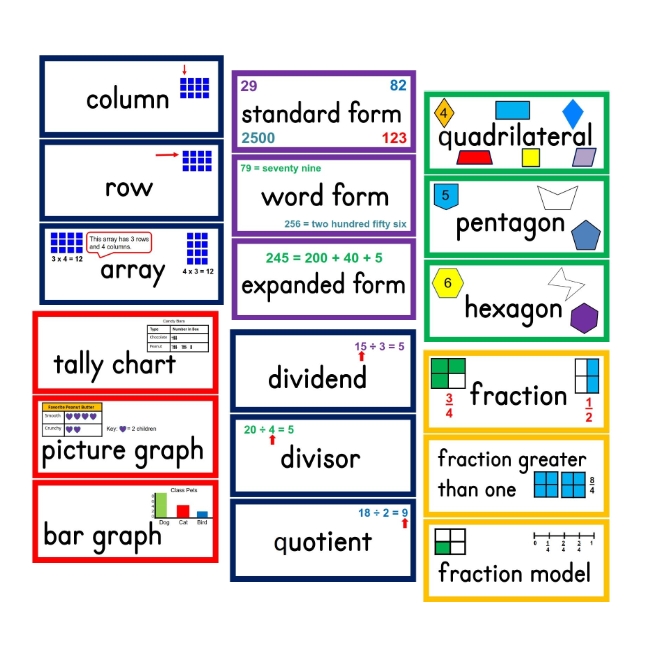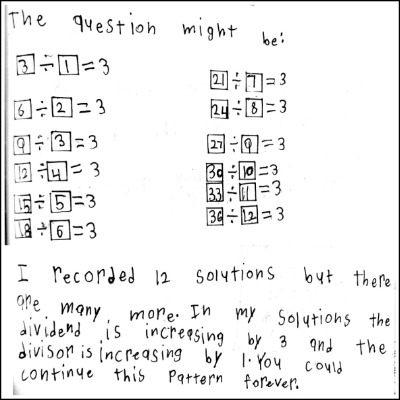Strategies to Support Math Writing
Use of a math writing criteria chart, or rubric can impact positively on the quality of students' math writing. Before
students can produce competent work they need to have a clear vision of
what ‘competent work’ looks like. The teacher’s role is to guide
students in discovering the criteria for competent work at any grade
level by modeling the criteria and providing exemplars for students. The
specifics will vary from grade to grade depending on the concepts and
skills already learned and in the process of being developed. Encourage
students to refer to the criteria chart, or rubric, whenever they check
or revise their work to make sure it fulfills the
criteria.
Good Math Writers:
- Select the best way to represent their thinking (e.g. using words, equations, a diagram, table, or graph)
- Use precise math vocabulary and symbols
- Give examples
- Describe any patterns they discover
- Show/explain the steps taken to solve a problem
- Explain their findings in a clear and organized manner
- Restate the question
- Answer all parts of the question
- Check that what they have written makes sense
Other strategies that teachers can use to support the development of math representation skills include:
- Model and display different ways of representing math information and findings (e.g. in words, pictures, diagrams, numbers, charts, graphs, tables, etc.)
- Allow students to decide how to record their understandings and findings
- Model appropriate terminology in context, both verbally and visually (e.g. through questioning, math charts, a Math Word Wall, Math Vocabulary Books, sentence starters, etc.) Encourage students to consult these resources for vocabulary and spelling.
- Display possible sentence starters for math writing as a scaffold for those who need them. Examples include:
Today in Math I learned ....
Today in Math I found out ....
Today in math I discovered ....
The easiest/most difficult part of today’s math lesson was...
One thing I learned in math today that I did not know before was...
The most important thing I learned in Math this week was...
I would explain to an absent student what I did/learned in Math today like this ...
I think the answer is .... because ....
The steps I took in solving this problem were ....
The strategy I used to find a solution to the problem was ...
To check my answer I ...
I still don’t understand ...
Another strategy I could use to solve this problem would be to ...
My Math goal for tomorrow is ...
- Encourage discussion, debate and clarification throughout the Math Workshop. Provide opportunities for students to share ideas with partners, in small groups, and in whole-class discussions. Students need to use and understand the language of math before they can use it effectively in writing.
- Encourage ELL students to use their first language to discuss or clarify information with others
- Emphasize self-achievement rather than competition and ensure that all students work is chosen at various times for class display
- Set questions/tasks that offer students the opportunity to explore a variety of solutions and discover generalizations or patterns at their own level of thinking, rather than limited questions which allow for one answer only. For example:
Closed Question: What is 6 x 20?
Open Question: A school has 120 students. They all come to school by bus and each bus carries the same number of students. How many students might there be on each bus? - Encourage students to use math talk by asking questions to help students develop appropriate vocabulary for talking and writing in mathematics. Conference/question students as they work on set tasks to help them make sense of the task, build self-confidence, and encourage mathematical thinking and communication. Possible questions might include:
- Where can you begin?
How would you restate the problem in your own words?
What information will you need to solve this problem?
Have you solved similar problems that would help?
Can you make a prediction?
How can you organize the information?
Can you draw a model to explain your thinking?
What would happen if ...?
Can you describe a strategy you can use to solve this?
What do you need to do next?
Do you see any patterns in your work?
How do you know your solution is reasonable?
How did you arrive at your answer?
How can you convince me that your answer makes sense?
Did you try anything that did not work?
How could your explanation be made clearer? - Provide regular, ongoing opportunities during math sessions for students to share their written representations to help them consider different ways to approach problems, as well as different ways of representing and explaining their thinking. Possible questions might include:
How could you use a diagram to represent this problem?
Explain why your strategy works.
How are ________'s and _________'s representations similar/different?
How are _______'s and _______'s strategies similar/different?
Which strategy is the most efficient?
How could you revise your model to make it clearer?
What equation/s would match this problem?
Is there more than one equation that would represent this?
For more ideas on how to create an interactive word wall to support the development of students' math writing skills see this page.

